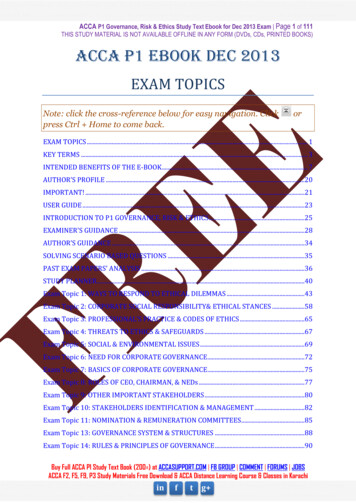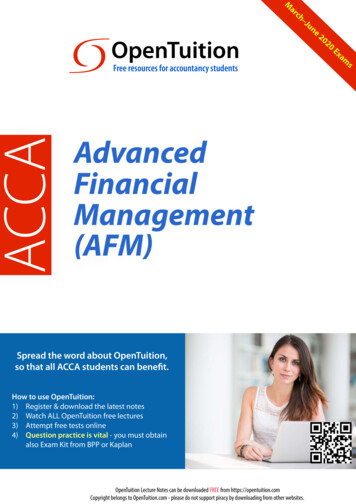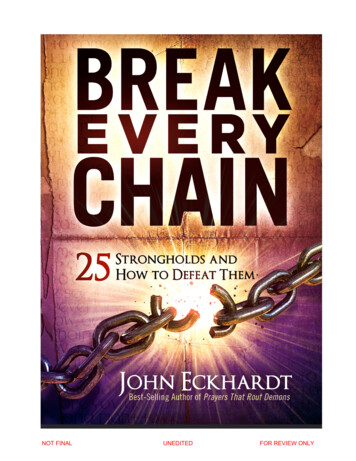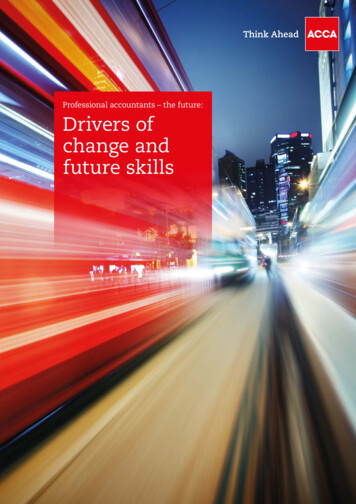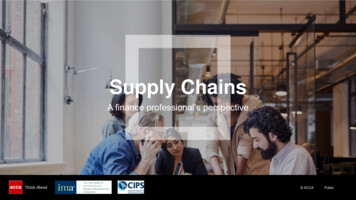
Transcription
Supply ChainsA finance professional’s perspective ACCAPublic
IntroductionThe pandemic has seen an increased focused on supply chains and procurement. The increasinglyintegrated nature of business models means that supply chain teams and their finance counterpartsneed to work ever more collaboratively in addressing the forthcoming challenges.This report looks at this essential relationship. It offers a Charter for Collaboration and then explores thebackground to the current developments and the areas of common interest. At each step it offers suggestedareas to think about for the finance professional.As the environmental, social and governance agenda increasingly becomes a focus for all organisations, so theimpact of this in their supply chains is as relevant as the steps that they themselves are taking. This requirescollaboration and data transparency, not least to address the reporting requirements of stakeholders andregulators.This report has been developed from interviews with finance and supply chain professionals across the globeand reflects their insights. This document is a summary. The full report can be downloaded from the ACCA andIMA websites.‘if [finance and supply chain teams] use different lenses to really understand what'sgoing on it will be challenging’ ACCAPublic
Charter for collaborationVisionTrusted FBPPlanning andforecastingData andtechnologyVisionManaging disruptionEstablish shared challenges and future vision that support the purpose ofthe entity and align to the strategic objectives in delivering products andservices to the customer in an effective and efficient manner.Prepare the entity to weather the next round of disruption and ensure thatthe modelling capabilities are available to allow understanding of theopportunities that appear.ManagingdisruptionTrusted finance business partnerCollaborative mindsetProvide relevant, accurate and informed advice to support decision making,including understanding the cost base and Cost-to-Serve, therebystrengthening the relationship between supply chains and finance.Recognise that collaboration is key – respecting the differences, maximisingthe commonality; approaching with a project-centric and collaborativemindset.CollaborativemindsetPlanning and forecastingVisibilityChange planning, budgeting and forecasting horizons in response to theevolving nature of the entity and the environment in which it operates,accepting that traditional cycles may no longer apply.End-to-end visibility is key across supply chains as entities look to enactstrategies that will drive sustainability goals. Understanding the full nature ofsupply chains is essential in this.VisibilityData and technologyEthical lensWork together to ensure that technology and data developments addresscollective requirements. Appreciating the importance of predictive analyticsand ensuring that the relevant data is available; understand how digitalsupply chains are making business models evolve.Use the ethical lens in common to assess the challenges in supply chainsand the behaviours of entities, especially as these lead to regulatorychallenges.Ethical lensESG agendaESG agendaRecognise the importance of the environment, social and governance(ESG) agenda, ethical supply chains and non-financial reporting, especiallyas regards suppliers across the supply chain network relationships and howthese can be understood.Risk and due diligenceRisk and duediligenceJointly engage in risk management and supplier due diligence activities asthe challenges continue to evolve. ACCAPublic
Procurement and Supply Chain CycleWhat is procurement and supply?The CIPS Procurement and Supply Cycle outlines the complexity and breadthof activities carried out by procurement teams. The procurement team areresponsible for overseeing the steps of the procurement cycle, covering coredepartment activities such as market analysis, sourcing, negotiation,contracting and supplier relationship management for goods, works andservices, covering both acquisitions from third parties and in-house providers.The process spans the whole procurement cycle from the identification ofneeds, through to the end of a services contract or the end of the useful life ofan asset. It involves options appraisal and the critical ‘make or buy’ decisions.Procurement teams analyse and management risk throughout the supplychain from availability of supply, price fluctuations and the continuousmonitoring of the micro and macro-economic environment for potential impact.Sustainability sits at the heart of procurement with approximately 80% of anorganisation’s sustainability impact sitting in the supply chain. Procurementsupports the sustainability goals of the organisation and optimises theenvironmental, social and economic impacts over the life cycle of productsand services.Supply Chain ManagementSupply Chain Management is the management of the flow of goods, servicesand suppliers from raw materials to the consumption by the consumer,requiring a network of suppliers that link the supply chain together. ACCAPublic
Industry 4.0 and Supply ChainsIndustry 4.0 is impacting supply chains in ways that are like the finance function. The ability tosimulate potential outcomes of strategies using modelling techniques is becoming a keymanagement tool. The concept of a digital twin to model the entity in virtual reality is an important.Visualise the introduction of a new product, or the commissioning of a new factory or piece ofequipment. What is the potential impact? This can be modelled in a simulated environment withoutlooking to committing to capital investments and waiting to see what the outcome might be.SimulationEntities are also taking positions on vertical and horizontal integration. This may be the acquisitionof entities, but also through more collaborative arrangements.Cloud computingIndustry 4.0 is about data, initiated by the Internet of Things allowing tracking of goods and theprediction of maintenance, as examples. All this data has a value and needs to be kept secure andis generally stored in the Cloud. Augmented reality let us visualise the use of products whilstadditive manufacturing (such as 3D printing) can impact how entities construct components orfinished products and may well shorten or change component supply chains.Autonomous systems, such as robot warehouse technologies, are changing the way that entitiesserve customers by running warehouses with far greater efficiency and thereby enabling some of thee-commerce transactions of consumers.All of this is becoming a reality and whilst not all entities will use all components, it is easy to seeboth how supply chains are being changed and also how the financial transactions that areembedded within them are evolving.Whilst typically we talk of supply chains in terms of manufactured goods, we should not forget theincreasing importance of service supply chains in many economies. These are essentially humancapital focused, but are facing many changes as a result of the technology trends highlighted byIndustry 4.0. Services make up a substantial proportion of many developed economies and aresuffering from resource constraints.Vertical andhorizontalintegrationAutonomous systemsIndustry4.0Additive manufacturingInternet of thingsCybersecurityAugmentedrealityBig dataThings to think about: How is your organisation’s business model changing? What is the impact on the supply chains? What are the implications for working capital management andforecasting? ACCAPublic
Sustainable Supply ChainsSustainability is a significant issue in supply chains. The UN Global Compact comments that ‘when supplychains are done wrong – by not taking into consideration the environmental, social and governanceperformance of suppliers – companies leave themselves open to significant operational and reputationalrisks. Impacts on people and the environment can be substantial and severe’.UN SDG’sand SupplyChainsWhilst we may focus on achieving net zero and similar targets, it is worthwhile commenting that the scopeof a sustainable supply chain is not just about the E. Many are also focused on workforce issues, such asconditions and child exploitation. These are relevant in supply chains, indeed, there are ethical issuesover the extraction of cobalt which is a key raw material in the development of batteries for electricvehicles. The issues are complex and often finely balanced.The ESG agenda is becoming significant in the discussion around supply chains. As entities look to movetowards addressing the necessary changes in their business models to achieve the global targets by2030, including the relevant UN Sustainable Development Goals, so there will inevitably be transformativesteps that they need to take. Often these may not have a direct financial return and finance teams need tobe attuned to this.It is important to recognise the need to improve processes in these areas. Shipping and air freightrepresent significant sources of emissions in supply chains, although in cost terms the ‘last mile’ ofdelivery to a consumer is often the costliest, both financially and in terms of emissions. ACCAPublic
Sustainable Supply ChainsISO 20400:2017 provides guidance on how to create sustainable procurement in three areas: Integrating sustainability into the organisation's procurement policy and strategy Organising the procurement function toward sustainability Integrating sustainability into the procurement processUN SDG’sand SupplyChainsAll of this leads to the consideration of emissions which the Greenhouse Gas Protocol categorises intothree scopes. Direct emissions, Scope 1, are those that the entity can directly control from its ownactivities. Indirect emissions are the subject of Scopes 2 and 3. Scope 2 is those indirect emissions suchas those from the use of electricity and heating or cooling. Perhaps most challenging are Scope 3emissions which occur in the value chain of the company, both upstream and downstream.Like any aspect of an entity, supply chains have a way to go in terms of managing emissions and creatingsustainability. For finance professionals this changing business model requires a deep understanding ofthe issues and strategies. As will be discussed later in the presentation, the level of knowledge at presentcan be small.Things to think about: What strategies is your organisation adopting in this area? What are your current and future reporting requirements? Can these be addressed from currentinformation flows? What risk management and due diligence strategies do you have in place? ACCAPublic
Why Supply Chains Matter toFinanceWe have seen some of the macro trends in supply chains. The reality is that entities are constantly looking toadapt their business models. That rate of adaptation is accelerating. Many of the drivers are becoming morepressing. Finance teams need to demonstrate a deep understanding of the business model. Planning andforecasting, amongst other aspects of their work, are predicated upon this. As supply chain teams react to theirinfluences, so finance needs to react too.Most critically in this ability to react is the skills of the finance business partner. Many of the supply chainprofessionals interviewed for this report stressed the importance and the benefits of a good finance businesspartner in delivering insights and supporting decision making. They are often integral parts of supply chainleadership teams. Being a trusted advisor requires credibility, reliability and intimacy but all of this can beundermined by a promotion of self-interest.Things to think about: How would you categorise the relationship with your Supply Chain and Procurement colleagues? Develop an action plan of current issues? What actions can you take to work more collaboratively?‘based on my observation generally there is a lot of room for improvement between thecommunication of the two groups’ ACCAPublic
Adding ValueHow does finance add value? The answer is that there are range of ways but the quote on the slide emphasisesthat it is important to speak a common language, and this spans many of the dimensions of collaboration.Firstly, what does a product cost and what does return does the entity achieve from any particular customer. It ispossible, indeed likely, that the traditional views of cost and profitability are not the whole story. Applyingconcepts such as ‘cost-to-serve’ may assist in understanding which customers are the most profitable – and itmay not be those who are thought of as the best. The ‘last-mile’ accounts for 53% of all costs in a supply chain,according to one estimate.In the pandemic we have seen an emphasis on liquidity of entities, and indeed, that is likely to continue asinflationary pressures continue to impact supply chains. The key relationship in the supply chain is a paymentone. When will I receive the monies owed in the relation to the goods or services provided. Helping suppliers,especially those smaller ones in supply chains remain solvent, has been key factor in the pandemic world. Thebalance of risk (those critical suppliers) and reward (the continuation of supply) is a challenging one, but one thatfinance needs to be working closely with relevant supply chain team members on.Due diligence is another area of collaboration. As we have seen in Industry 4.0 earlier, vertical and horizontalintegration are becoming key drivers for entities. Yet, as one supply chain lead commented, their team membersare often left out of such processes, however, they may have a detrimental impact on other key supplyrelationships. Adding value is about thinking broader.Treasury traditionally had little involvement in supply chain issues. Cash positions were static, yet as data hasbecome more available, so it has become easier to manage these more dynamically. And in turn this opens upthe concept of supply chain finance. ACCAPublic
SME lensThe SME lens in supply chains is very important. In any network, as in reality supply chains are networks, youwill find many SMEs. These may be component manufacturers or other suppliers. However, as McKinsey notedin the second quarter of 2021 only 2% of those surveyed, typically larger organisations, had visibility of theirsupply chain beyond the second tier, and only 21% had visibility of their second tier. Few actually understandthe network and the vital role that each level plays.The drive towards non-financial disclosures across supply chains is cascading some of the requirements throughthese networks. Not least in helping larger entities to understand their Scope 3 emission targets. SMEs oftenlack the infrastructure to respond either from a compliance perspective or in enacting the necessary changes totheir operating models.In turn, if the numbers that McKinsey noted in relation to the awareness of the players in an entity’s supply chainwere repeated for SMEs it is likely that the numbers would not look any better. One practitioner noted that one oftheir struggles was to help their clients understand their supply chains beyond the first tier. As 2021 has broughtdisruption, so the criticality of supply chains has become important.Things to think about: As large organisations are you working with your tier 2 and tier 3 suppliers effectively enough? Do you understand full extent of the network of suppliers both before and after your organisation in thechain? Are you able to report effectively on the data in the chain; do you have the processes and systems to doso? ACCAPublic
‘A perfect storm’? Disruption is thenormSeveral of the research contributors referred to the disruption of 2021 as a ‘perfect storm’. The pandemic alonewas one factor but what it did do was exacerbate the fault lines.Before the pandemic struck much of the conversation was on trade and tariffs. There were several examples ofthese actions. What it underlines is the trade and supply chains can be a political tool. That said, the actionstaken were mainly around more consumer focus goods.The pandemic has also seen politicians controlling the spread using border controls. Air routes have beendisrupted and the number of flights significantly reduced as demand contracted. Whilst airlines have adaptedplanes to ship cargo (and there have been innovations there).Much of the conversation has been around port congestion, which in part has been due to pandemic restrictionsrestricting operations. This in turn has caused a shortage of containers and an in balance of trade which theshipping companies have struggled with.Things to think about: What risk management strategies do you have in place to anticipate potential impacts of disruptions? How flexible are your planning, budgeting and forecasting processes? Are you able to model a world ofconstant disruption? What longer term strategies are you evaluating? ACCAPublic
An end in sight?The reality is that disruption is a natural cycle of events.There are several implications in the medium to longer term of the pandemic on supply chains and hence theinteraction with the finance community. The first is around the planning cycle. The nature of the disruption is such thatthe traditional planning and budgeting cycles of are being replaced by more flexible scenario modelling and predictiveanalytics techniques. For these to be fully effective they need data drawn from sources across the supply chain as wellas a closer collaboration to understand they dynamics of how customers and demand changes will impact sourcing andthe availability of raw materials.Entities have focused on the management of inventories through just-in-time processes that are often hard to stop andrestart at regular intervals, as an example think about car assembly and the number of components that need to arriveat one place within a short timescale and the challenges of the pandemic and delays in production becomeunderstandable. Whilst some entities can think about a transition from just-in-time to just-in-case, for many this may notbe possible. As finance professionals, understanding these drivers is essential as it models future performance.There have also been shifts in global economics – not all of these arise directly from the pandemic but may well havearrived at a similar time. During the 1990s and 2000s the global economy operated on low-cost manufacturing,typically in Southeast Asia and China. Some of those cost advantages are beginning to lessen. As the world looksacross the ESG agenda towards the sustainable development goals in 2030, so some manufacturers are bringingproduction closer to the consumer – near shoring. Again, for finance teams this changes the business model andinvolves understanding and evaluating certain investments.All these trends stress the importance of the close relationship between supply chain and finance professionals, but theimportance of the finance business partner as a true trusted advisor who can interlink between the dimensions and beinvolved in the strategic and operational decisions that this changed world dictates. ACCAPublic
Data is key, technology enablesHaving a common understanding is important to an effective relationship. Being able to look through the samelens reduces misunderstandings and improves decision making. In the world of Industry 4.0, as we have seen,data is key. Data is the means by which we can analyse and interpret the present and look towards the futureusing techniques such as predicative analytics. Having a universal data model is essential to this.Achieving this requires visibility across the supply chain. Studies suggest that organisations have progress tomake in improving visibility and data sharing across their networks. Many are aware of their first tier suppliersand may be their second tier but only a small number are aware of tier three and beyond. Whilst in any tradingrelationship there are always issues of confidentiality and commercial sensitivity, as supply chains become morecomplex, so there is a need to open up. This places a burden on smaller entities in supply chains to have thesystems and processes in place to manage such connectivity.In part this visibility can be addressed by the use of smart contracts and blockchain technology. A smart contractis a self-executing contract with the terms of the agreement between buyer and seller being directly written intolines of code. The code and the agreements contained therein exist across a distributed, decentralizedblockchain network. The code controls the execution, and transactions are trackable and irreversible.‘if [finance and supply chain teams] use different lenses to really understand what's going onit will be challenging’ ACCAPublic
Data is key, technology enablesHaving the data allows organisations to utilise analytics to understand trends and improve forecasting. Financeand supply chain teams are on a similar path from the use of descriptive analytics, what has happened in thepast, to more predictive analytics, what might happen in the future. In part this may use artificial intelligence andmachine learning to facilitate the understanding of trends, however, moving from a reactive to a proactivemindset is important for organisations going forward.The data flows also allow end-to-end visibility of the supply chain, and this can be represented in a Supply ChainControl Tower. This is technology that provides a visual representation of the flow of goods across a supplychain linking to ERP solutions and drawing data from partners and from RFID and other sensors. It can assist inidentifying disruptions and potential blockages on networks and facilitate forward actions.Things to think about: How does the data strategy of the organisation address the needs of the Supply Chain and Financeteams, especially in regard to non-financial disclosures? What procedures do you have in place to monitor emerging regulations and the impact on the datarequirements? How are organisational strategies embracing technological shifts that will impact finance and supplychains? ACCAPublic
Ethical supply chainsNone of this discussion can be too far from the ethical agenda. As professions Supply Chain and Finance havestrong ethical bases.There is an increasing regulatory focus on understanding the impact of supply chains. As an example, Germanyintroduced legislation in June 2021 that provided for fines of up to 2% of global turnover for entities that did notmeet the necessary disclosure requirements around the ethical nature of their supply chains, not only from anecological perspective but also from a workforce lens. Other countries are looking to introduce similar legislation.The impact is to put the ethical nature of supply chains at the heart of disclosures, whilst also potentially creatinga burden on smaller entities who face differing forms of compliance from many larger entities.A Supply Chain Code of Conduct can be one way to assist entities to help instil financial and social transparencyin the supply chain, with the intention of creating accountability and full disclosure around issues such as humanrights, health and safety and environmental impacts.All of this leads to Supply Chain Risk Management, not just from a disruption perspective, but also from anethical perspective. What are the values of the entity and what other entities is it willing to trade with?Things to think about: How to evolving ethical strategies impact business models? How do enterprise wide risk management strategies embrace supply chain risks? How do finance and supply chain teams collaborate in supplier due diligence?‘It is about understanding to what extent that impacts your business’ ACCAPublic
How to stay in g/insights-and-trends ACCAPublic
Supply Chain Management is the management of the flow of goods, services . Industry 4.0 Simulation Vertical and horizontal integration Internet of things Cybersecurity Big data Additive manufacturing Cloud computing Autonomous systems . Sustainability is a significant issue in supply chains. The UN Global Compact comments that 'when supply
